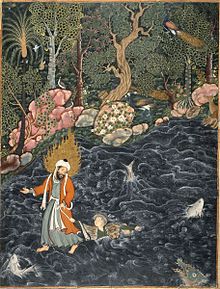
The Hamzanama (Persian/Urdu: حمزهنامه Hamzenâme, lit. 'Epic of Hamza') or Dastan-e-Amir Hamza (Persian/Urdu: داستان امیر حمزه, Dâstân-e Amir Hamze, lit. 'Adventures of Amir Hamza') narrates the legendary exploits of Hamza ibn Abdul-Muttalib, an uncle of Muhammad. Most of the stories are extremely fanciful, "a continuous series of romantic interludes, threatening events, narrow escapes, and violent acts".[1] The Hamzanama chronicles the fantastic adventures of Hamza as he and his band of heroes fight the enemies.
The stories, from a long-established oral tradition, were written down in Persian, the language of the courts of Persianate societies, in multiple volumes, presumably in the era of Mahmud of Ghazni (r. 998–1030). In the West, the work is best known for the enormous illustrated manuscript, the Akbar Hamzanama, commissioned by the Mughal emperor Akbar about 1562. The written text augmented the story as traditionally told orally in dastan performances. The dastan (storytelling tradition) about Amir Hamza persists far and wide up to Bengal and Arakan, as the Mughal Empire controlled those territories.[2] The longest version of the Hamzanama exists in Urdu and contains 46 volumes comprising over 45,000 pages.[3]

- ^ Beach, 61.
- ^ Although nominal similarities, they story is not about the famous Hamza, prophet Muhammad's uncle. The Bustan of Amir Hamzah (the Malay version of Dastan-e-Amir Hamza); Farooque Ahmed, The Sangai Express-Imphal, May 25, 2006 Amir Hamza-book review[permanent dead link]
- ^ "داستان امیر حمزہ | ریختہ". Rekhta (in Urdu). Retrieved 2023-03-28.